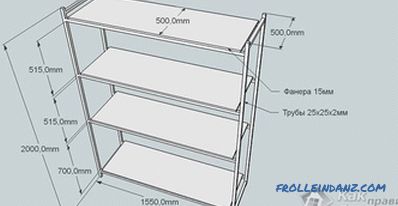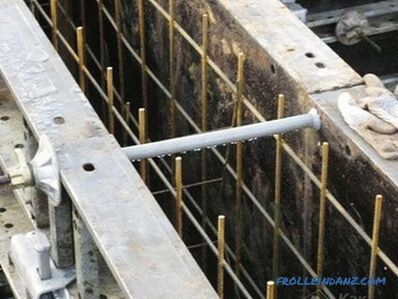In order to decorate the garden plot in an original way, you can independently make paths from tree cuts. The manufacture of such tracks will significantly change the appearance of the site, and in view of the fact that the material itself can be purchased for little money or not at all, considerable savings are possible. This article will talk about how to make garden paths out of wood with your own hands.
First of all, you need to think about the purpose for which you will need a path, for example, for walking or gardening beds. If there is a desire to create an eco style at the dacha, then the use of this natural material would be an ideal option.
Advantages and disadvantages of
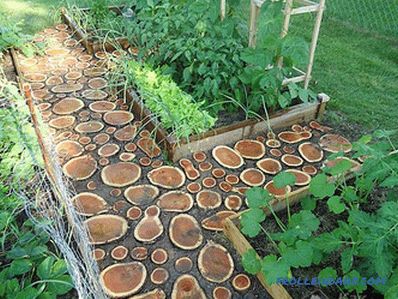 Garden path from wood cuts
Garden path from wood cuts
This article will help to see the advantages and disadvantages of this design option garden. We will also consider the instruction explaining how step by step you can pave paths from wood cuts.
Wood tracks have certain advantages:
- an environmentally friendly material;
- an exclusive look because of the uniqueness of the picture;
- the individuality of each track;
- low cost and ease of manufacture;
- material and tools can be found right at the cottage.
It is also necessary to mention the shortcomings of this material:
- fragility - the main drawback;
- susceptibility to rotting and damage by insects;
- fire hazard with prolonged exposure to open flame.
In fact, there are fewer disadvantages than advantages, and therefore you can safely get down to business.
We cut the blanks
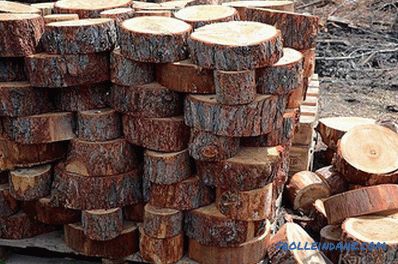 Blanks
Blanks
The cuts can be of two shapes: semicircular and round, 0.3–1 m in size, about 10 cm in height.
There are several ways to pave wooden walkways. The shape of the track can be arbitrary - in this version it will look much more beautiful and attractive.
In addition to the tracks, you can build a decorative ladder or bridge from the cuts.
Paths from wood cuts
 Gasoline and electric saws
Gasoline and electric saws
First you need to prepare the tools for work. In this case, you will need a chainsaw (or electric saw). Logs for cuts in advance must be well dried, otherwise (if laid in the raw state) they can crack and deform. If the material dries when buried in the ground, the view of such a track will be unattractive and will have to be redone.
On how carefully the material is treated with an antiseptic, the service life of the structure depends, be it garden paths, bridges or ladders. Typically, processing is done with linseed oil, a solution of copper sulfate or used machine oil.
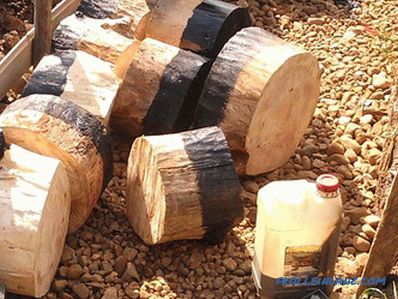 Processing the lower part of the saw cuts by working out
Processing the lower part of the saw cuts by working out
After processing, the material should dry well. Then it is necessary to treat the product with a layer of waterproofing from melted bitumen. Bitumen should be applied to the lowest part of the cut, which will be immersed in the ground. There is another option for waterproofing - immerse the bottom of the saw cut into a container with molten bitumen and gasoline added to it. After this procedure, you need to give the wooden products to dry well.
In the markets, ready-made impregnation is sold that contains protective substances - this method will be more reliable.
Laying garden paths

In order to lay the cuts beautifully, it is necessary to mark the territory with pegs, which need to be hammered along the entire perimeter of the future path , then the cord is taken and pulled between the pegs.
When the path is winding, the marking is performed using sand.
After preparing the markings, a trench of about 30 cm in depth is dug out, in which a drainage system is built, designed to protect the cuts from moisture. To do this, rubble is laid on the bottom of the trench and rammed. From above you need to put geotextiles and make sanding. Each of the layers is poured with water and tamped with quality. The thickness of the resulting layer should not exceed 10 cm.
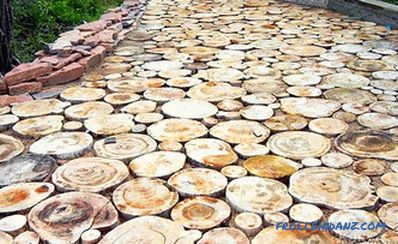 The space is filled with smaller spans
The space is filled with smaller spans
Now You can begin to lay the cuts, placing them closer to each other and selecting the diameter of the workpieces. To fill the joints between the saws, use crushed stone, sand or pebbles. Often, for beauty, the space between the paths is sown with lawn grass.
Along the edges of the walkway, you can decorate using higher cuts, decorative stones, or high-quality filling with primer. Flowers will surely be a beautiful decoration of the garden path.
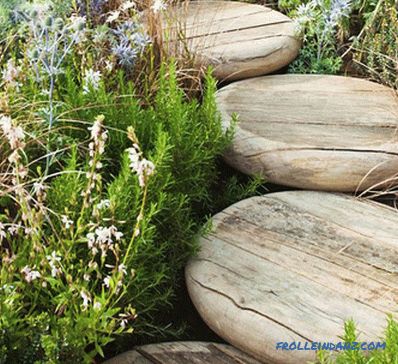 Garden ladder made from tree cuts
Garden ladder made from tree cuts
Irregularities on the garden The plot can be hidden by means of a garden path, made in the form of steps, especially if there is a slope on the plot.
It should be remembered that the garden path must be primed annually to protect the tree from rotting, which will increase the life of the path.
Paths from boards
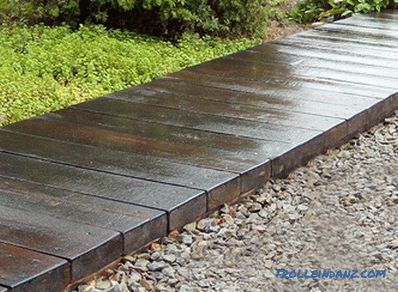 Garden path from transversely located boards
Garden path from transversely located boards
As an option , as a material for garden paths, you can use wooden planks. Most often, this track has the appearance of solid flooring. Plates are stacked both in the transverse and in the longitudinal direction. To the path was winding, the edges of the plates are specially trimmed or stacked in a special way.
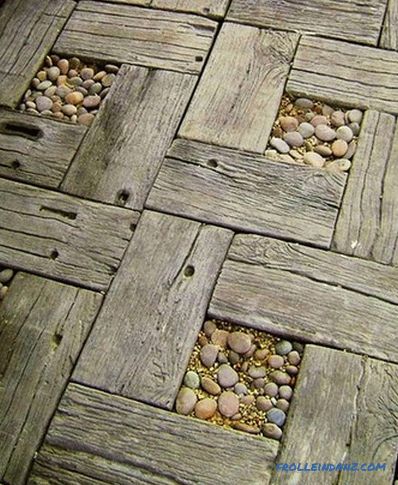 Parquet path
Parquet path
Using this approach, you can simulate various options, for example, a pattern, similar to parquet.
 The track design resembles a railway
The track design resembles a railway
And if the boards are placed at some distance from each other and the space between them fill with gravel or gravel, then the structure will resemble a railway.
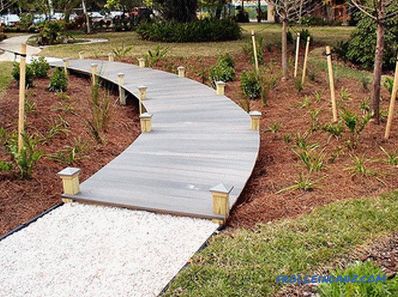 Wooden walkway above the ground
Wooden walkway above the ground
You can make a garden path from planks laid out with solid flooring. This path is made slightly raised by about 10 cm. This has a great advantage - there is no contact of the tree with the soil, and the airspace allows the tree to dry quickly after rain, which significantly contributes to the long use of the garden path.
To create your own garden path from the elements of the tree, you need to spend a lot of time and effort, but you can get a real masterpiece. Such a path will be a beautiful and extraordinary addition to the garden decoration.
Video
In recent years, wooden-covered walkways
Wooden decking boards have been very popular:
Photo
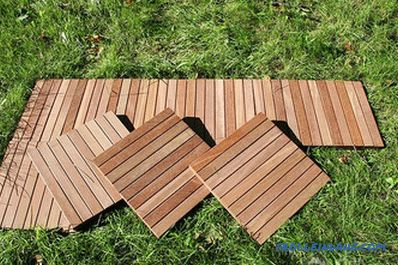 From wooden shields
From wooden shields
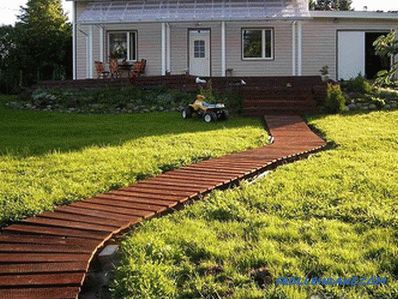 K the house is made of boards
K the house is made of boards
 The treated wood is not afraid of moisture
The treated wood is not afraid of moisture
 A beautiful garden path made of planks
A beautiful garden path made of planks
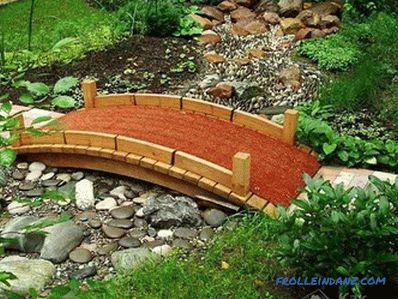 A dry stream with a wooden bridge
A dry stream with a wooden bridge
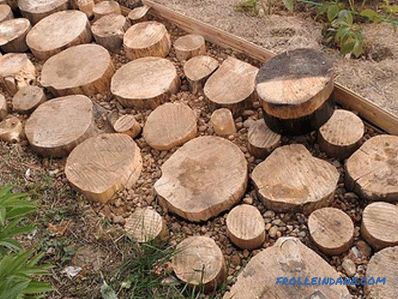 Design of the garden path
Design of the garden path
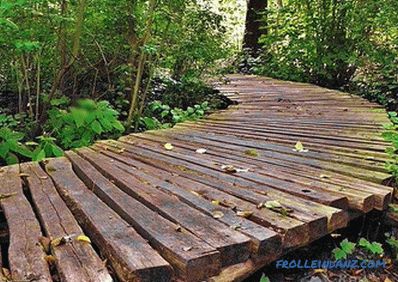 Garden option from boards
Garden option from boards
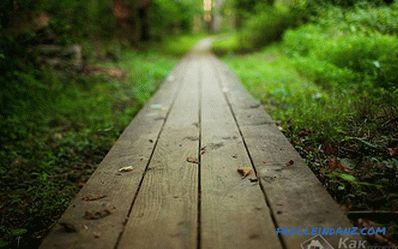 From longitudinally laid boards
From longitudinally laid boards

